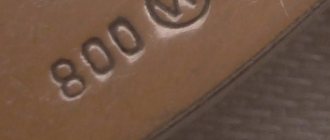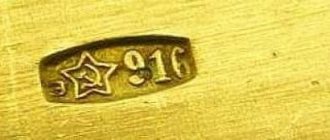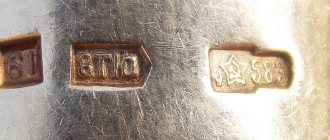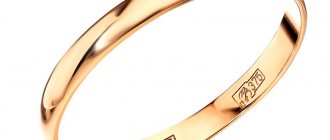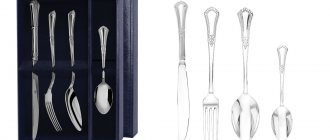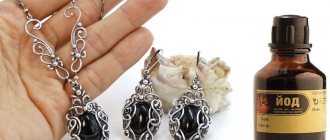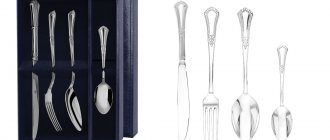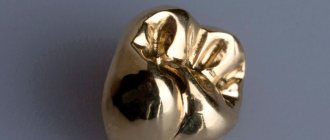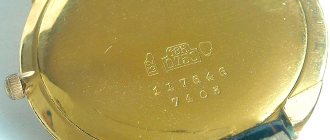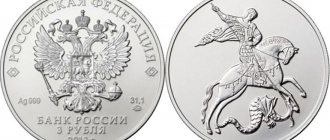Silver hallmarks are markings on a precious metal that indicate the purity of the alloy. Different countries used their own marking systems, but the masters had one goal - to show the buyer the quality of their creation. Pure silver has never been used in production - the metal is too soft and not suitable for dishes and jewelry.
Silver hallmarks often consist of combinations and numbers that craftsmen have used to mark their pieces for hundreds of years. Numerical marks indicating the percentage of pure silver in the material are common. The marking was unified in the states that signed the Convention on Control and Labeling.
800 sterling silver, what is it, what kind of metal?
800 silver is considered a low-grade alloy, which is used primarily for casting cutlery. The “800” stamp on the metal indicates that the product contains 80% pure silver, with the remainder being various impurities.
The alloy corresponds to 19 carats, 12.8 lots or 77 spools.
It is often called the “dining room”, and the peak of its popularity occurred during the reign of Catherine II.
800 silver spoon
Gold samples
The term "fineness" indicates the amount of precious metal in an alloy. But how can we understand this? For example, a ring purchased in Russia has a three-digit number stamped on it, while a ring from the USA or Europe has a two-digit number. All these markings have the same meaning, they just present it differently. This is due to different systems by which samples are determined and different units of measurement.
Spool system
The main unit of measurement here is the spool. By weight, it is equal to 1/96 of a pound, which is approximately 4.266 g. This is how the golden share was measured in ancient times (1711–1927), so products with two digits on the surface are considered a rarity.
There were 7 samples in total - 36, 56, 72, 82, 92, 94 and 96. If you have 36 spools and multiply this figure by 2.44 (so many pounds equal 1 kg), and then by 4.266, you get the familiar three-digit 385 sample .
Metric system
This classification was introduced by the Soviet Union immediately after the spool one. It is much more practical and shows the quantitative gold content in the precious material in grams familiar to us. That is, in 1 kg of alloy of the same 385 purity of pure gold there will be only 385 grams, and the rest (615 g) comes from other components - nickel, copper, silver, etc.
Lot system
This specification was used for a very long time in Western Europe, where the mass of precious metals was measured in marks. It is similar to the spool valve, it is also considered old-fashioned and is no longer used today. I will not say how much one stamp weighs, but will simply clarify how it compares to a three-digit sample.
To convert a lot value to metric, it must be multiplied by 125 times and then divided by 2. There are samples of 6, 8, 12, 14 and 16 lots. For a product with mark 6, after manipulation it turns out that it corresponds to 375 standard. Therefore, the 6 lot alloy contains 375 grams of pure gold.
Carat system
This classification prevails in the USA and in some European countries. A carat is the official unit of measurement for precious stones; it is equal to 0.2 g. A drop of gold weighing 1 g is denoted 5 k according to the American system. However, this is not how the sample is determined.
The essence of marking a precious product is that the material from which it is made is divided into 24 parts. That is, the usual one kilogram is replaced by 24 carats, and the value of pure gold is applied to the product. For example, a sample of 18 k means that for 24 parts of the entire alloy there are eighteen parts of pure gold (75%). If this number is multiplied by 1000 and divided by 24, the result is 750 fineness, which means the content of 750 grams of gold in the alloy.
Correspondence table between different systems
| Sample ratio of different measurement systems | ||||
| Metric | Zolotnikovaya | Lotovaya | Carat | Gold in % |
| 990–999 | 96 | 16 | 24 k | 99% and above |
| 958 | 92 | 15,3 | 23 k | 95,80% |
| 916–917 | 88 | 14,6 | 22 k | 91,67% |
| 875 | 84 | 14 | 21 k | 87,50% |
| 833 | 81 | 13,3 | 20k | 83,33% |
| 800 | 76.8 | 12,8 | 19.2k | 80,00% |
| 792 | 76 | 12,7 | 19 k | 79,17% |
| 750 | 72 | 12 | 18 k | 75,00% |
| 625 | 60 | 10 | 15k | 62,50% |
| 583–585 | 56 | 9,3 | 14 k | 58,33–58,50% |
| 500 | 48 | 8 | 12 k | 50% |
| 417 | 40 | 6,7 | 10k | 41,67% |
| 375 | 36 | 6 | 9 k | 37,50% |
| 333 | 32 | 5,3 | 8k | 33,33% |
800 sterling silver: composition and properties
In its pure form, lunar metal is not used to create jewelry because it does not have sufficient strength. In order to change its casting properties, improve performance characteristics, and increase hardness, the metal is alloyed with various additives.
For 800 silver, the main alloying substance is copper. Sometimes the alloy also contains zinc, aluminum, and less often nickel. The amount of lunar metal in one kilogram of such an alloy is 800 grams, 200 grams are additives.
Due to the increased copper content, the alloy may have a yellowish tint, which is not typical for higher grades. Copper also helps to reduce anti-corrosion properties; the product quickly darkens from air and water environments.
LiveInternetLiveInternet
This photo shows some modern and antiquated silver samples
Standard silver standards in force in Russia, Ukraine and the CIS countries have the following numerical values: 800, 830, 875, 925, 960 and 999. Other countries may have their own unique silver samples, the content of pure noble metal in such samples, may be determined historically.
800 silver
800 silver bowl, made in Russia.
800 sterling silver with foreign mark.
- This is low grade silver.
- The alloy of this sample has a slightly yellowish tint.
- Contains: 80 percent silver and 20 percent copper.
- Has excellent casting properties.
- It oxidizes more intensely than other standard silver alloys in the air and turns yellow.
- Has high mechanical strength.
- The alloy is 875, often equated by jewelers to 375 gold.
- This low-grade silver is often used to make tableware and is less often used in the production of jewelry.
- 830 silver tray, made in Russia.
- This is a low grade alloy.
- It contains: 83 percent silver.
- Its characteristics are almost no different from the previous alloy.
- Jewelers often undertake to make jewelry from this alloy.
875 silver
Silver plate, stamped 875, made in Russia.
- 875 silver is standard high-grade silver, which is the border between low-grade and high-grade alloys.
- The pure silver content is 87.5 percent.
- Less than other standard alloys, 875 alloy is prone to oxidation in air.
- It also retains its bright white-silver color very well, like a pure noble metal.
- It is mechanically a high-strength alloy.
- The alloy of this sample was very popular - in tsarist times and in the Soviet Union.
- Today this alloy is in wide demand - in the Russian Federation.
- The alloy of this sample is also called “Russian silver”.
- Russian jewelers willingly undertake to make various types of household and jewelry items from it.
- This alloy is often used to produce fine silverware and jewelry.
- This high-grade alloy is also in great demand abroad.
84 sterling silver
An antique silver salt shaker with a 84-karat hallmark, where a lady in a kokoshnik looks to the right.
- 925 sterling silver is characterized as a unique, very high quality alloy.
- This alloy is also called “sterling silver” or simply “sterling”.
- It is synonymous with the concept of “coin silver”.
- Sometimes called “pure silver”.
- Contains 92.5 percent pure noble metal.
- This alloy has high ductility properties.
- Easily subject to shaping.
- It has elastic and hard properties.
- Retains a bright shine - like pure silver.
- It is considered the world leader among all known standard jewelry alloys.
- Today it is rightly called the “international silver standard.”
- Most of the world's silver jewelry is made from this type of alloy.
- It has ideal: physics - chemical characteristics.
- This alloy is slightly susceptible to oxidation by oxygen.
- When properly stored, sterling silver retains its original silvery appearance for a long time.
- Jewelry made from this popular alloy has the appearance of sterling silver and is very durable.
- This is a universal alloy from which jewelers can make almost all jewelry.
- Sterling alloy is widely used to make: high-end silverware, jewelry, filigree silverware, bullion coins, and even ionizers to ionize water.
960 silver
Wedding silver ring, highly polished, made in Russia, with a 960 hallmark and a lady in a kokoshnik facing to the right.
- Engagement silver ring, rhodium-plated, made in the former USSR, with a 960 hallmark and a five-pointed star, inside of which are the symbols of the Soviet Union: the hammer and sickle. Silverware containing Soviet symbols, usually a star with a hammer and sickle, indicates that the silverware or silver jewelry was made in the former USSR.
- 960 alloy is a high-grade silver alloy.
- Silver alloy with the number - 960, contains about - 96 percent pure noble metal.
- 960 alloy, like 925 silver, contains a small amount of copper.
- According to its characteristics, it is not much different from pure silver.
- Silver 960 has excellent ductility properties, is well processed, polished, slightly oxidized in air, contains a large percentage of silver, its color is very close to pure noble metal.
- This alloy is used mainly where very fine work is required - with enamel or in the manufacture of fine filigree (filigree silver).
- Jewelry made from this alloy looks great. Today, not a single filigree can do without a silver alloy, with the number 960. Silver items made from this type of alloy are very vulnerable and easily change their shape during wear.
- In Russia, it is the maximum permissible for the production of jewelry.
- A unique silver ring made from pure silver.
- Silver alloy 999 is the highest standard, which contains only one percent of various impurities.
- It is also called “high purity alloy”.
- This silver alloy is usually obtained at refineries.
- Today, it has not yet been possible to obtain chemically pure silver, without foreign impurities. Often the alloy of 999 fineness is identified with pure silver or with 1000 fine silver.
- 1000 silver is an abstract concept.
- A soft and easy to process 999 silver alloy, it is extremely rarely used in jewelry production.
- 999 sterling silver is used for the manufacture of small jewelry parts - jewelry or small-sized silver items.
- This alloy mainly serves as a valuable material from which bank silver (coins, bars) and parts for the radio engineering industry are made.
- Pure silver is often used as a decorative and protective coating.
- Electrolytically - pure silver is applied to various objects: silver, brass or copper, to improve their aesthetic properties, or to protect products from the action of an aggressive chemical environment.
- Today, not a single jeweler would risk making large-sized jewelry from pure silver, and a true connoisseur of silver would not want to wear it all the time and would store it carefully in a case.
Non-standard or obsolete silver hallmarks, for example: 720, 750, 916 and 84
Silver table spoon with hallmark 916.
- Silver bowl with 916 hallmark and a five-pointed star with a hammer and sickle. Next to the hallmark mark, there is another mark – the name plate.
- 750 sterling silver engagement ring.
830 silver
Silver cup, stamped 875, made in the former USSR.
Silver tray, hallmarked 875, produced in the former USSR.
Today, in many Russian and Ukrainian museums, as well as in the collections of silver connoisseurs, jewelry silver left over from the distant past has been preserved. Jewelry silver in Tsarist Russia, until 1927, in accordance with the spool system, was branded with spool hallmarks. The spool system for marking silver in Russia was based on the Russian pound. The assay system in Russia was created by the great reformer Tsar Peter the Great, who by his decree defined four hallmarks of silver: 96, 90, 84 and 62. Silver 84 hallmark, today referred to as metric 875 hallmark, was considered the most popular hallmark in Tsarist Russia.
Sterling Silver
Silver ring made in Russia from 925 sterling alloy. There are two hallmarks on the ring: one with the image of 925 standard and a lady in a kokoshnik with her face turned to the right; the other is a brand - a name tag.
Two 925 sterling silver rings, coated with a layer of white rhodium, made in Ukraine.
925 sterling silver ring with pearls and zirconium inserts, made of sterling silver, plated with a thin layer of white rhodium,
is a foreign-made product.
925 silver saucer, early 19th century, marked Sterling, well preserved to this day.
999 silver
Engagement silver ring, made in Russia, with a 999 hallmark and a lady in a kokoshnik facing to the right.
Bank silver bar, weighing 500 grams, made in Russia from pure silver.
The investment silver coin “St. George the Victorious” was issued by the Central Bank of the Russian Federation in 2009, with a nominal value
three rubles, 999 fine and weighing 31.1 grams.
Sample 800: narrow application and wide distribution
The scope of application of 800 sample does not expand over time. The alloy is used to create products that must be durable because they will be subject to daily physical impact.
Cutlery made of 800 silver
Making silverware
Most often, the precious metal is used to make various cutlery.
History of hallmarks on Russian silver
Before the advent of assay supervision in 1700, in the territory of Tsarist Russia only silver products were subject to hallmarking. There was no single standard; artisans and large jewelry factories marked their products with their own mark. The stamp only indicated that the product was made of lunar metal.
The testing system established by Peter I remained virtually unchanged until 1917. According to Peter's decree, four gold and four silver standards were established. The decree protected the interests of bona fide producers, fair competition, and the state itself.
The mark of the tsarist era looked like this: first, the numerical value of the sample in the spool system was indicated, then - the imprint of the female profile in the kokoshnik, and lastly the initials of the foreman or plant manager were indicated. Often the year of manufacture was also indicated on the product.
The silver testing system changed with the Bolsheviks coming to power. The spool system was replaced by the metric system, and the woman's head was replaced by the worker's head. The marking system was revised again in 1958 and was not changed again until the collapse of the Soviet Union.
Russian Federation
Soviet standards were in effect until 1994. The young state experienced a change in stigma. The image of a woman in a kokoshnik, turned to the right, returned to him. The code of the assay inspection, as in the USSR, is marked with a Russian letter. Currently, the following six hallmarks can be seen on silver items:
- 800;
- 830;
- 875;
- 925;
- 960;
- 999.
The most common items I have seen are 925 sterling silver. As soon as I get my hands on something made of a precious metal, I immediately look for a hallmark with its hallmark. 999 silver is considered pure metal. Silver itself is very soft and easily deformed.
Labeling in other countries
For European countries, branding begins earlier. Many of them indicate the fineness in carats. The lot or spool system for indicating the purity of the alloy is practically never used anywhere.
English
In the second half of the 12th century, many masters in England had individual marks. They could indicate them on the finished product only after checking by the guild of jewelers.
In 1701, assay offices opened throughout the country, making it easier to control the quality of jewelry work. The mark of those times looked like this:
- The image of a walking lion is a sign of a government institution;
- An image indicating the year of manufacture;
- An image unique to each individual city;
- A stamp indicating payment of taxes;
- Try;
Modern English products do not have a stamp indicating payment of taxes.
French
The oldest mark found on French jewelry dates back to 1272. It reported the name of the master and the city of production.
The oldest hallmark on French jewelry, 1272.
Hallmarking became mandatory in 1672. Since then, the mark has not undergone significant changes. Products from France are marked as follows:
- First, an imprint of the head of Hermes is indicated - a sign that the jewelry has passed the state authentication test;
- The letter designation encodes the production date;
- The sample is indicated last;
German
The first hallmarks of jewelry in Germany date back to 1289. Branding was not mandatory in the country, but eminent masters often indicated their authorship on their works.
It became mandatory in 1548; a new decree required markings on all products with a purity greater than 4 lots. The print contained the lot value, the unique mark of the master, and the identification mark of the reigning monarch.
By 1800, a particularly popular hallmark, the “Celtic Mark,” had become established. It was equal to 800 samples of lunar metal.
In modern Germany, 800 silver remains highly sought after, and the hallmark looks like this:
- A unique sign of a factory or artisan;
- Numerical value of the sample;
- State confirmation sign - a crescent with a crown;
Marking of silver in Italy from the mid-30s of the 20th century to the present
In the 20s, a radical government led by Benito Mussolini (Benito Amilcare Andrea Mussolini) came to power in Italy, which set the task of bringing order to the marking of silver. New branding rules were approved in 1935. The system was well thought out - each manufacturer was assigned its own number. The number was enclosed in a rhombus, and two additional letters were applied, indicating the province. Until 1944, fascist symbols - an ax and birch twigs - were a mandatory element of the brand, but after the fall of Mussolini’s regime, the design was removed.
Legislation in 1968 made further adjustments to hallmarks on silver items in Italy. The diamond was replaced by a rectangle with a star on the left side, the individual number and the province designation were retained. This marking of silver is still used today.
Silver items by Italian masters often appear among lots at antique auctions. The Very Immortant Lot features items that can become long-term investments.
Cost of 1 gram of 800 silver
The cost of any alloy depends on the prices for pure precious metals established by the Central Bank of the Russian Federation. To find out how much a particular silver sample costs, you need to multiply the current price of the highest alloy by the required coefficient.
The price of pure silver for 2022 is about 58 rubles per gram.
Then you can calculate the current cost of 800 samples as follows:
58 * 0.8 = 46.4 rubles per gram.
One gram of silver
Which authorities regulate the marking of gold samples?
In 1999, the act “On the hallmarking of products made from precious metals” was issued, which regulates the testing of alloys for gold content and their certification at the legislative level. This work is performed by the Ministry of Finance of Russia, or more precisely, its division - the Assay Inspectorate. If the properties of the product declared by the manufacturer are confirmed, then it puts its own mark (see above), and also, if necessary, issues a certificate of quality.
Why do you need to standardize the composition?
Standardization is necessary to document the quality declared by the manufacturer. The stability of the house or tower during construction will depend on this. That is, a standard is something to be compared to in production.
In the jewelry industry, the price category is also added to this value. Thus, gold jewelry made from different gold samples have different prices and differ in mechanical properties.
Ways to install a fake
You can reliably distinguish a fake from a genuine precious metal in jewelry workshops, purchase shops, and pawn shops. If there is no opportunity to contact professionals, you should use the following recommendations:
- First of all, you need to carefully examine the sample on the product. Lack of markings may indicate a fake.
- Try dropping iodine onto an inconspicuous part of the object. Genuine precious metal will darken upon contact with the substance.
- The new product must not have scuffs, scratches or other defects. This appearance is only acceptable for antique items.
- You can try to gently scratch the surface with a needle. If a different color of metal appears at the site of the scratch, this is a fake.
What brands of gold are there in Russia?
The metric system is used in the Russian Federation and other CIS countries. The hallmark shows the pure gold content of the alloy. Not all brands are suitable for making jewelry that can be bought in jewelry stores. Thus, 7 samples are officially released in Russia:
- 375;
- 500;
- 585;
- 750;
- 900;
- 916;
- 958.
All gold products are made from them. 585 is considered the most common, the rest are used much less frequently.
Silver samples according to GOST
GOST 30649-99 establishes 6 silver standards. You can see their composition in the table below.
| Try | Silver content | Impurity content |
| 800 | 80% | 20% |
| 830 | 83% | 16% |
| 875 | 87,5% | 12,5% |
| 925 | 92,5% | 7,5% |
| 960 | 96% | 4% |
| 999 | 99,9% | 0,1% |
Causes of silver blackening
The most common cause of blackening is the oxidation of copper contained in the alloy. Human sweat, which is a waste product from the body, contains sulfur, which can also cause darkening of lunar metal.
Low-quality materials also darken from contact with cosmetics, water, household chemicals, and aggressive reagents.
800 alloy cutlery usually has an additional protective coating, so it does not darken from contact with food and water.
Which sample is better?
If you rely on cost, then the highest will be 999 samples. It is placed on gold products that do not contain alloying elements. However, from a practical point of view, it may not be the best since pure gold jewelry is so soft that it can be bent by hand. That is, a ligature in the alloy is necessary in any case.
Expert opinion
Vsevolod Kozlovsky
6 years in jewelry making. Knows everything about samples and can identify a fake in 12 seconds
750 is considered the most successful of all samples, since the nickel, silver, copper and platinum it contains provide optimal properties when making jewelry. It is especially valued by craftsmen who melt and create their own masterpieces. The only problem is the price, which is why jewelry with such a hallmark is rarely produced.
The most popular is 585, from which about 90% of all gold rings, earrings and other jewelry assortment are produced.
Recommendations for the care and storage of silverware
Silverware should be stored separately from other items, preferably inside special boxes or cases.
It is recommended to purchase a detergent suitable for silver items. It is necessary to wash dishes immediately after eating and do not allow food to dry on the surface. Precious tableware should be washed separately so as not to accidentally scratch it on other dishes.
It is recommended to regularly clean items with soap or soda solutions.
Do not wash low grade metal products in the dishwasher.
Reviews
For several years, the whole family has been using silver cutlery from the Sokolov brand, which corresponds to 800 standard. We only take out the set for holidays and try to take care of it. The appliances look as attractive as the day they were purchased.
Masha L., Kastroma
Lydia I. g, Ivanovo
Silver spoons for the child were brought as a gift from Italy. On the handles of the spoons I saw the number 800 and a five-pointed star. It turned out that the picture means the country of origin, and the number means the sample of silver. I really liked the gift.
I discovered someone’s forgotten set of silver salt shakers in a recently purchased house. The items apparently date back to the times of the USSR, I realized this from the 800 mark next to the worker’s head. The set is clearly of historical value; I kept it as a souvenir.
Vitaly N., Yaroslavl
